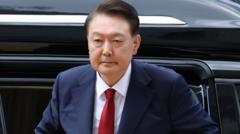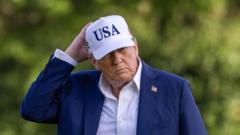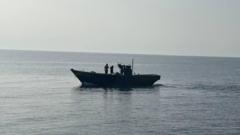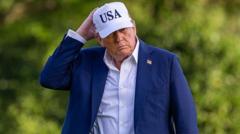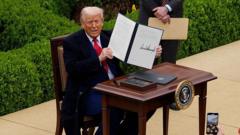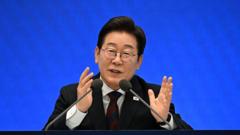On July 9, 2025, six North Korean fishermen who had inadvertently drifted into South Korean waters were repatriated, marking a diplomatic gesture from the newly elected president, Lee Jae Myung. This act represents a notable shift in approach from the previous administration under Yoon Suk Yeol, which had adopted a hardline stance towards North Korea.
South Korea's New President Enhances Ties by Repatriating North Korean Fishermen

South Korea's New President Enhances Ties by Repatriating North Korean Fishermen
In a significant move towards improving inter-Korean relations, South Korea returns North Korean fishermen as a goodwill gesture.
The fishermen, who had been stranded since their boats malfunctioned, were returned at the maritime border off the eastern coast. Mr. Lee has emphasized dialogue and reconciliation since assuming office last month, contrasting sharply with his predecessor's confrontational policies. Communication between the two Koreas had diminished markedly in recent years, with North Korea categorizing the South as its primary adversary and issuing nuclear threats amidst escalating tensions.
The South Korean authorities first discovered two of the fishermen in March off the west coast, while the other four were found in May near the east coast. Officials explained that both incidents resulted from mechanical failures that left the fishermen adrift.
While the inter-Korean maritime boundary is heavily fortified, instances of North Korean fishermen accidentally entering South Korean waters are not uncommon. Some managed to reach South Korea seeking asylum, while others found themselves in dire conditions due to equipment failures. North Korean boats, often rudimentary in design, frequently wash up on Japan and Russia's shores, sometimes with survivors onboard.
Typically, when North Korean fishermen are located, South Korean naval forces escort them to shore, where they undergo thorough debriefing. This process is crucial to discerning their intentions, as it determines if they wish to return home or defect. Historically, repatriating North Koreans has involved complex political dynamics, with both Koreas leveraging these exchanges for propaganda purposes.
The return of the fishermen could indicate a new chapter in inter-Korean relations, with hopes that more diplomatic discussions will ensue under President Lee's leadership, moving away from the antagonism of the previous era.
The South Korean authorities first discovered two of the fishermen in March off the west coast, while the other four were found in May near the east coast. Officials explained that both incidents resulted from mechanical failures that left the fishermen adrift.
While the inter-Korean maritime boundary is heavily fortified, instances of North Korean fishermen accidentally entering South Korean waters are not uncommon. Some managed to reach South Korea seeking asylum, while others found themselves in dire conditions due to equipment failures. North Korean boats, often rudimentary in design, frequently wash up on Japan and Russia's shores, sometimes with survivors onboard.
Typically, when North Korean fishermen are located, South Korean naval forces escort them to shore, where they undergo thorough debriefing. This process is crucial to discerning their intentions, as it determines if they wish to return home or defect. Historically, repatriating North Koreans has involved complex political dynamics, with both Koreas leveraging these exchanges for propaganda purposes.
The return of the fishermen could indicate a new chapter in inter-Korean relations, with hopes that more diplomatic discussions will ensue under President Lee's leadership, moving away from the antagonism of the previous era.

